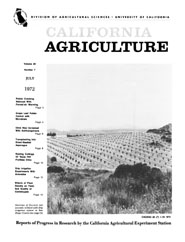


University of California
California Agriculture
|
|||
|
|||

Cover:
Overview of five-acre test avocado orchard with drip irrigation system in San Diego County.
July 1972
Volume 26, Number 7 News and opinion |
|||
|
University of California, 1301 S. 46th St., Bldg. 478 Richmond, CA
|